With just over two weeks until Canterbury is bursting with contemporary music, cast your eye over the events listings for this year if you haven’t already done so. The festival celebrates the music of the Baltic, with compositions and performers from countries including Estonia, Latvia and Lithuania alongside a veritable banquet of contemporary works by other composers.
 The Choir of King’s College, Cambridge will be giving the UK premiere of Arvo Pärt’s Adam’s Lament in a concert in the Cathedral on Friday 27; Pärt is this year’s Guest Composer, and the same concert also features his Cantus in Memoriam Benjamin Britten as well as Britten, Gorecki and Nicholas Maw.
The Choir of King’s College, Cambridge will be giving the UK premiere of Arvo Pärt’s Adam’s Lament in a concert in the Cathedral on Friday 27; Pärt is this year’s Guest Composer, and the same concert also features his Cantus in Memoriam Benjamin Britten as well as Britten, Gorecki and Nicholas Maw.
Choral evensong earlier in the afternoon on the same day will include Pärt’s I Am The True Vine and Magnificat, with the Choir of Canterbury Cathedral directed by David Flood. Elsewhere during the festival season, there’s also a conference on Baltic music and musicologies, and papers on the music of Pärt in particular.
The BBC Big Band will be appearing in the Gulbenkian Theatre on Sunday 21 with Duke Ellington’s jazz-wise glance at Tchaikovsky’s Nutcracker, whilst the New Perspective Ensemble on Friday 27 presents music by Magnus Lindberg and Oliver Knussen. There’s also a premiere by the festival director Paul Max Edlin, and music by Sofia Gubaidulina, Poul Ruders, Ligeti, Sørensen, Nørgård and others. Some of the festival will be broadcast on Radio 3’s ‘Hear and Now’ series, including Glass’s Symphony no.3 for strings and pieces by Terry Riley and Pärt on Thursday 26.
This year marks the launch of Sounds New Poetry, and includes the University’s very own Patricia Debney, Senior Lecture in Creative Writing, in a discussion about the relationship between words and music called ‘Roundtable’ on Tuesday 24 at 6pm.
WIth a host of other events including poetry, workshops, film and talks, there’ll be something for everyone. Full details on the Sounds New website, or click here to download the flyer.
Stimulate your senses…





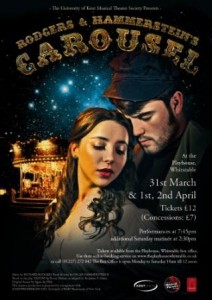

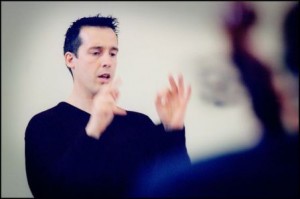 His music defies those neat genre-defining labels that critics and music shop stockists love: classical, minimalist, techno, jazz. Combining repetition, polyphonic rhythmic inventiveness, sampled and electronic sounds and a tonal language glittering with bright colours, it’s a music that refuses to be neatly pigeon-holed.
His music defies those neat genre-defining labels that critics and music shop stockists love: classical, minimalist, techno, jazz. Combining repetition, polyphonic rhythmic inventiveness, sampled and electronic sounds and a tonal language glittering with bright colours, it’s a music that refuses to be neatly pigeon-holed.
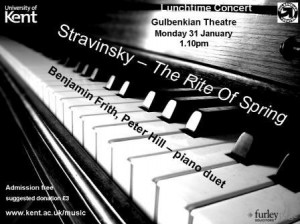 The first of this term’s lunchtime concerts on Monday 31 January in the Gulbenkian Theatre is an unmissable occasion: two of the country’s leading pianists grappling with Stravinsky’s notorious, barbarous tour de force. More commonly heard in its orchestral incarnation, the piece caused a scandal at its premiere in 1913; this is an opportunity to hear it in its piano-duo arrangement, which loses none of its vibrantly destructive energy.
The first of this term’s lunchtime concerts on Monday 31 January in the Gulbenkian Theatre is an unmissable occasion: two of the country’s leading pianists grappling with Stravinsky’s notorious, barbarous tour de force. More commonly heard in its orchestral incarnation, the piece caused a scandal at its premiere in 1913; this is an opportunity to hear it in its piano-duo arrangement, which loses none of its vibrantly destructive energy.
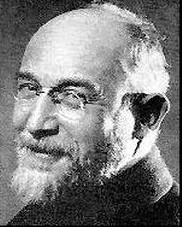
 Composed in 1917, at a time when the rest of the world had gone mad with wholesale slaughter and mechanised forms of destruction, Satie’s evocation of the Classical period is a reminiscence of, almost a hankering after, an old order where unity and structure prevailed; at the same time, his usurping of its principles reflects the breakdown of society and its values which was going on around him: despite its apparent jocular tone, the shadow of the Western Front is never far away.
Composed in 1917, at a time when the rest of the world had gone mad with wholesale slaughter and mechanised forms of destruction, Satie’s evocation of the Classical period is a reminiscence of, almost a hankering after, an old order where unity and structure prevailed; at the same time, his usurping of its principles reflects the breakdown of society and its values which was going on around him: despite its apparent jocular tone, the shadow of the Western Front is never far away.
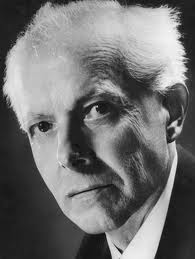 It’s a masterpiece: the visual element is so brilliantly rendered in the orchestral score that it almost makes a staged realisation unnecessary. The glittering yet bloody armoury, the sweeping views of Bluiebeard’s seemingly limitless kingdom, the dazzling treasury where the priceless artefacts are tinged with blood, the lake of tears – the music creates these scenes so well, you almost don’t need to see a stage production’s version: better to leave it to the imagination.
It’s a masterpiece: the visual element is so brilliantly rendered in the orchestral score that it almost makes a staged realisation unnecessary. The glittering yet bloody armoury, the sweeping views of Bluiebeard’s seemingly limitless kingdom, the dazzling treasury where the priceless artefacts are tinged with blood, the lake of tears – the music creates these scenes so well, you almost don’t need to see a stage production’s version: better to leave it to the imagination.